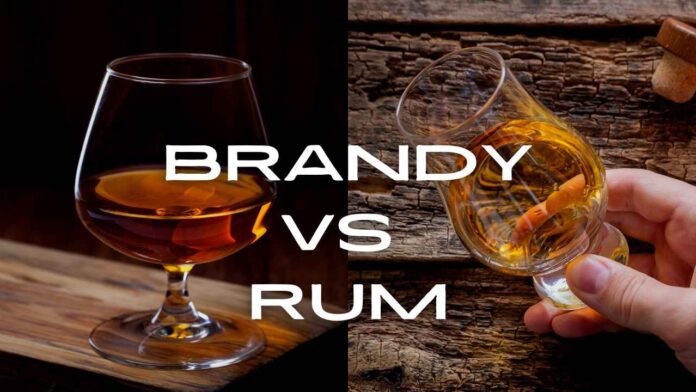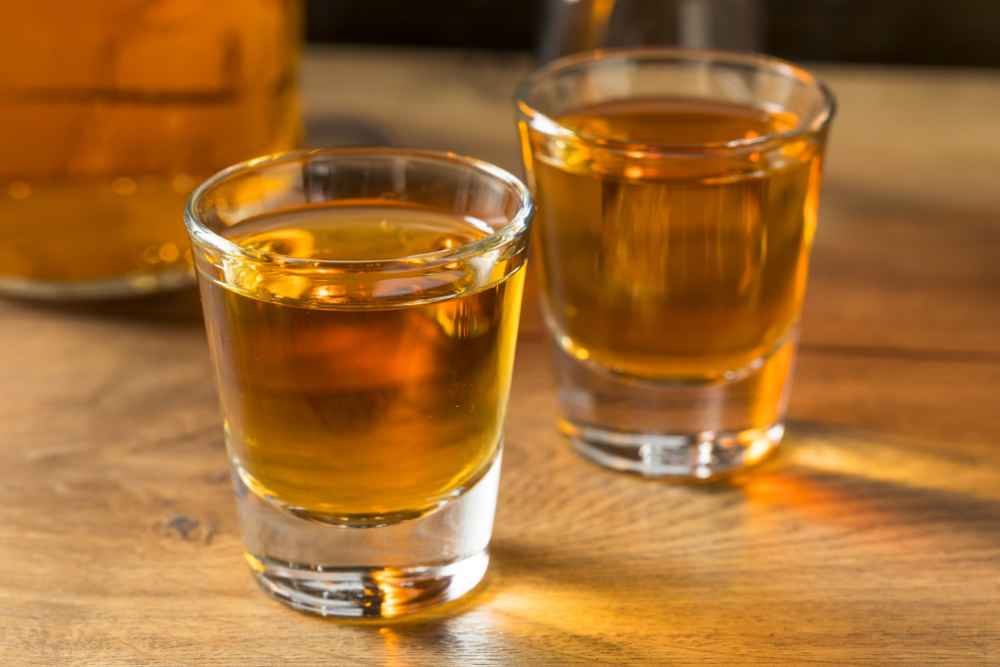This page may contain affiliate links. Please see our Disclaimer for more information. Always drink responsibly and adhere to your local legal drinking age.
Introduction
Are you a cocktail enthusiast or seeking to broaden your knowledge of spirits? If so, this in-depth look at the key differences between two popular liquors – Brandy and Rum – is just what you need.
Dive into the world of these distinct beverages as we explore their origins, production methods, unique flavors, alcohol content levels, and more. By understanding their contrasts and similarities, you’ll be better equipped to appreciate each drink’s nuances and know which suits your taste buds best.
Key Takeaways:
- Brandy is typically made from distilled wine or fermented fruit juices like grapes, apples, and peaches. At the same time, rum relies on sugarcane and its by-products, like molasses or sugarcane juice, for its delectable sweetness.
- The production methods of brandy and rum differ in the types of stills used. Brandy uses pot stills, which lend a richer flavor profile than column stills often used for making rum.
- The aging and maturation process plays a crucial role in producing high-quality spirits like brandy and rum. Cask-aged spirits can have different levels of maturity despite being the same age.
- Understanding these fundamental differences between brandy vs. rum will help cocktail enthusiasts better appreciate each drink’s unique flavors and characteristics while knowing which one suits their taste buds best.
Difference Between Brandy Vs. Rum
The primary distinction between brandy and rum is the ingredients used to create these popular spirits. As cocktail drinkers, understanding this difference can help you appreciate each drink’s unique flavors and characteristics.
Brandy is typically made from distilled wine or fermented fruit juices like grapes, apples, and peaches. The process involves fermenting the fruits into wine before undergoing distillation to produce brandy.
Another critical difference between rum and brandy is their respective production methods. For instance, during distillation, brandy uses pot stills, which lend a richer flavor profile than column stills often used for making rum.
Finally, alcohol content also varies between these two spirits: most brandy brands have an alcohol content ranging from 35% to 60%, whereas rums typically contain a higher level of alcohol — usually ranging from 37.5% up to 80%.
What Are Brandy And Rum?
Brandy and rum are both types of alcoholic beverages that are made through the process of fermentation and distillation. They have different primary ingredients, production methods, and flavor profiles.
Definition And Origin
Brandy and rum hold a special place for their rich flavors and histories in spirits. Tracing its roots back to ancient Greece and Rome in the 16th century, brandy was initially created to preserve wine during transportation.
As distillation techniques improved, this spirit quickly gained popularity across Europe.
Rum, on the other hand, originated in the Caribbean during the 17th century as sugar production flourished in that region. The discovery that molasses – a byproduct of sugarcane refining – could be fermented and distilled led to the creation of this iconic spirit.
Unlike brandy, which primarily uses fruit juice or wine as its base ingredient, rum boasts sugarcane juice or molasses. As trade routes expanded during colonial times, demand for rum skyrocketed due to lower costs than brandies resulting from shorter trade routes and more affordable ingredients.
Primary Ingredients
Brandy and rum boast distinctive primary ingredients that set them apart from each other, ultimately defining their taste and character. To create the rich flavor profile of brandy, winemakers begin with wine or fermented fruit mash, typically derived from grapes.
On the other hand, rum relies on sugarcane and its by-products, like molasses or sugarcane juice, for its delectable sweetness. Using these sugary components results in a unique melding of sweet and complex flavors in every sip.
For example, consider famous cocktail concoctions such as mojitos or daiquiris – where using rum effectively brings delightful sweetness without overpowering other ingredients in your drink.
Production And Types
Brandy and rum have distinct production processes that lead to their unique flavor profiles. Brandy is made by distilling wine, typically from grapes and other fruits like apples or pears.
The distilled product is then aged in oak barrels, which can contribute additional flavors to the final development.
On the other hand, rum is usually produced by fermenting sugarcane molasses or sugarcane juice before it’s distilled and aged. This results in a sweet and spicy flavor profile, making it a popular choice for tropical cocktails like Mojitos and Daiquiris.
Understanding the different production methods of these two spirits can help you choose one that suits your taste preferences when making cocktails or enjoying them as an after-dinner drink.
The Distillation Process
During the distillation process, brandy is typically distilled twice in copper pot stills, while rum can be distilled multiple times in either pot or column stills.
Brandy’s Distillation Process
Brandy is made through distillation, which results in the concentrated wine becoming a high-proof spirit. Here’s how it’s done:
1. The base wine is heated in a pot still or column still, which vaporizes the alcohol.
2. The alcohol vapors are collected and cooled, producing a clear liquid with a higher alcohol content.
3. This liquid is then aged in oak barrels to impart flavors such as vanilla and caramel.
4. Brandy can be further distilled to increase its alcohol content, resulting in variations such as Cognac and Armagnac.
5. The final product can range from light and fruity to rich and complex, depending on the fermentation and distillation methods.
Rum’s Distillation Process
Rum is made through a process of fermentation and distillation. Here are the key steps involved in the distillation process:
1. Fermentation: The base material, molasses or sugarcane juice, is mixed with water and yeast to start the fermentation process.
2. Distillation: Once the mixture has fermented, it is distilled in a still. During this process, the alcohol is separated from the water and other impurities in the mix.
3. Separation: The rum is then separated from any remaining solids that may have carried over during distillation.
4. Ageing: The rum can then be aged in oak barrels, contributing to its flavor and color.
It’s important to note that different types of rum undergo other distillation processes. Dark rums are typically aged for extended periods and have more complex flavors due to their longer time spent in oak barrels. Light rums are aged for a shorter period, resulting in a more delicate flavor profile.
Overall, the distillation process plays a critical role in determining rum’s final flavor and quality.
Aging And Maturation
The aging and maturation process plays a crucial role in producing high-quality spirits like brandy and rum. Cask-aged spirits can have different levels of maturity despite being the same age.
This is because the spirit interacts with the wood of the cask, which influences its flavor and color over time. The goal of maturation is to remove impurities while improving the taste and aroma of the distilled spirit.
For example, cognac gets its rich caramel color from oak barrels, aged for at least two years, while superior old pale (SOP) brandy can be aged for up to six years in oak barrels, providing a more complex and smooth flavor profile.
In conclusion, aging and maturation are essential factors that affect a drink’s taste, aroma, and quality. It’s important to understand that even though two spirits may have similar ages or ingredients, their unique production methods determine their final taste profiles.
Brandy lovers may appreciate an extra-old bottle for sipping after dinner. At the same time, rum connoisseurs go for dark rums with smooth finishes due to extended periods of aging in oak barrels or other wooden vessels like sherry butts or bourbon casks.
Flavor Profiles
Brandy is known for its fruity and nutty flavors, while rum boasts sweet and spicy flavors.
Brandy’s Fruity And Nutty Flavors
Brandy is known for its delicious fruity and nutty flavors that can be attributed to the base product used in its production – wine or fruit mash. The fermentation process of these products produces aromatic compounds like esters, which provide a range of fruity flavors such as apples, plums, and berries.
Nutty flavors are also developed during the aging process in oak barrels.
Brandy’s unique flavor profile makes it an excellent choice for both sipping neat or mixing into cocktails like classic sidecars or Brandy Alexanders.
Rum’s Sweet And Spicy Flavors
Rum’s sweet and spicy flavors are one of the drink’s most attractive characteristics. The flavor profile ranges from light sweetness to warm spices, bright, herbaceous florals, or an unmistakable “funk.” The sweet notes come from a combination of molasses or sugarcane syrup used to make rum.
These sugars create a smooth honey-like texture and add caramelized hints to the spirit. However, it is the spices that truly set rum apart. Essential oils like cinnamon, clove, nutmeg, and ginger root-infused directly into the drink during production can produce aromatic solid flavors.
With so many options available within this category alone based on production nuances such as the distillation process with pot stills vs. column stills or color gained through aging in oak casks coupled with ingredients ranging from specific types of yeast strains used to indigenous blends of sugarcane, there’s no limit when it comes down choosing what suits your taste buds best!
Alcohol Content
Brandy typically has an alcohol content ranging from 35% to 60%, while rum’s alcohol content can range from 37.5% to as high as 80%.
Brandy’s Alcohol Content
Brandy is a type of spirit with an alcohol content ranging from 35% to 60%. The alcohol concentration depends on the aging process, with longer-aged brandies having a higher alcohol content.
For example, Hors d’âge brandy typically has an alcohol content of around 40%, while X.O can have up to 55% alcohol by volume.
However, even though brandy contains high levels of alcohol, it also offers some potential health benefits when consumed in moderation.
Rum’s Alcohol Content
Rum is a distilled alcoholic beverage typically made from sugarcane juice or molasses, and its alcohol content can vary depending on the type. Light rums have an alcohol content of around 37%, while gold rums usually have a higher alcohol content of 40% to 54%.
Some premium-aged rums can even have up to 80% ABV. The ethanol concentration in rum affects its flavor profile, with higher concentrations providing a more robust taste and burn.
Brandy Vs Rum
To help you better understand the key differences between brandy and rum, we have compiled a comparison table for easy reference. Here’s a quick breakdown of their characteristics in a side-by-side comparison:
| Aspect | Brandy | Rum |
|---|---|---|
| Origin and Definition | A distilled spirit made from wine or fermented fruit juices, mainly grapes. | A distilled spirit made from sugarcane or its by-products such as molasses. |
| Primary Ingredients | Grapes or other fruit juices | Sugarcane or molasses |
| Production and Types | Graded into V.S., V.S.O.P, X.O, and Hors d’âge | Not graded in the same way as brandy; various types based on color and flavor |
| Distillation Process | Double or single distilled, aged in oak casks | Column or pot distilled, aged in oak casks or stainless steel tanks |
| Flavor Profiles | Fruity, nutty, and often with notes of oak | Sweet, spicy, and often with notes of caramel and vanilla |
| Alcohol Content | 35% to 60% | 37.5% to 80% |
| Historical Pricing | Generally more expensive due to longer trade routes and costlier ingredients | Historically cheaper due to shorter trade routes and cheaper ingredient base |
This table provides an overview of the fundamental differences between brandy and rum. Consider these factors when choosing between the two spirits for your next cocktail.
Health Benefits And Risks
Moderate consumption of brandy and rum can have potential health benefits, such as reducing the risk of heart disease due to their antioxidant properties.
Moderate Consumption And Potential For Reduced Risk Of Heart Disease
Moderate alcohol consumption has been shown to have potential health benefits, particularly regarding reducing the risk of heart disease. However, it’s important to note that excessive drinking can lead to various health problems.
It is worth noting that while there is a correlation between moderate alcohol intake and improved cardiovascular health, it’s essential not to rely on alcoholic drinks as the sole means for maintaining a good heart condition.
Excessive Consumption And Risks Of Liver Damage
Excessive alcohol consumption, including too much brandy or rum, can significantly increase the risk of liver damage. Heavy alcohol intake is linked to three liver disease types: liver cirrhosis and liver cancer.
Drinking beyond your limit could result in long-term health issues such as digestive problems and increased risks of chronic diseases like diabetes, cancer, or heart issues.
Therefore, moderate drinking is crucial for minimizing the health risks associated with brandy and rum while still enjoying their flavorful tastes.
Pros And Cons Of Brandy And Rum
Brandy’s strengths include its smooth taste and ability to pair well with dessert, while its weaknesses lie in its high alcohol content and potential for intoxication. On the other hand, rum’s strengths are its versatility in cocktails and soothing properties, but excessive consumption can lead to liver damage.
Brandy’s Strengths And Weaknesses
Brandy is a favorite among cocktail drinkers worldwide, but it has its strengths and weaknesses. Here are some of the pros and cons of brandy:
Strengths:
– Brandy contains more antioxidants than whiskey, making it a healthier choice.
– Its smooth, fruity flavor makes it an excellent choice for an after-dinner drink.
– Brandy has been known to have a calming effect on people, which makes it perfect for those who want to relax after a long day.
Weaknesses:
– Although brandy contains antioxidants, the amount is not enough to offset potential health problems associated with alcohol consumption.
– One shot of brandy contains 97 calories and 14 grams of alcohol, so drinking too much can lead to intoxication.
– Brandy can be expensive compared to other alcoholic beverages.
Rum’s Strengths And Weaknesses
Rum is a classic spirit that has been enjoyed for generations. If you are a cocktail lover, you should know its strengths and weaknesses. Here they are:
Strengths:
1. Rich Flavor Profile: Rum offers a range of flavors, from sweet and fruity to robust and complex, making it versatile in cocktails.
2. Health Benefits: Rum has been found to promote heart health during winters, support a healthy heart, help with the common cold, diabetes, sore muscles, and scurvy and act as an effective antiseptic, according to studies.
3. Low Carb Content: A single serving (1.5 ounces) of rum contains 97 calories and no carbs.
Weaknesses:
1. Alcohol Content: While one serving of rum may not have many calories or carbs, it still contains 14 grams of alcohol which can cause intoxication if consumed excessively.
2. Risky Consumption: Excessive consumption of rum can lead to liver damage, so occasional drinking is recommended.
3. Dark Rum’s High Alcohol Content: Dark rum is made from caramelized sugar or molasses and aged for more extended periods in heavily charred barrels, which gives them more robust flavors and also makes the alcohol content higher than light rums.
Knowing the strengths and weaknesses of rum can help you make more informed decisions when enjoying this classic spirit in your cocktails!
FAQ
1. What is brandy, and what distinguishes it from rum?
Brandy is a type of spirit made from distilled wine or fermented fruit juice, while rum is distilled from sugarcane byproducts such as molasses or pressed sugarcane juice. Brandy tends to have a higher alcohol content and a more complex flavor profile than rum.
2. How are brandy and rum typically consumed?
Brandy is often enjoyed neat or on the rocks, while rum can be served straight, mixed into cocktails, or used in cooking/baking recipes. Both spirits are versatile ingredients that lend themselves well to various culinary applications.
3. Are there any health benefits associated with consuming brandy vs. rum?
While neither spirit has significant nutritional value, some studies suggest that moderate consumption of certain types of brandy (such as red wine-based varieties) may have heart-healthy benefits due to their antioxidant content.
4. What factors should I consider when choosing brandy and rum for my cocktail creations?
The taste profiles of these two spirits differ significantly – if you’re looking for an aromatic, warming drink with notes of vanilla and oak, go for cognac/brandy; if you are seeking lighter flavors like coconut and tropical fruits with a hint of sweetness, then white or dark rums are good options! Additionally, age plays a key role – Aged-brands generally tend towards complexity, darker hues & richer depth. In contrast, younger ones carry fresh fruity undertones dominated by the base ingredient (i.e., sugar cane).
Conclusion: Which One To Choose – Brandy Or Rum?
In conclusion, the differences between brandy and rum are significant, but neither is inherently better. It ultimately comes down to personal preference and what you want in a drink.
Brandy may be perfect for sipping as an after-dinner drink or paired with dessert, while rum offers endless possibilities for cocktails. Regardless of which one you choose, both brandy and rum can provide health benefits when consumed in moderation.





















